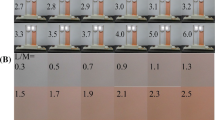Summary
Selenite is selectively co-precipitated with lead sulphate. In weakly acid solutions the selenite ions are attached to the lead sulphate particles probably the PbSO4 being charged electrically by adsorbed Pb2+-ions in excess. Moreover, in neutral solutions selenite will co-precipitate with PbSO4 as lead selenite.
Using a suspension of lead sulphate small amounts of selenium may be enriched in samples of very different materials. In most cases the effect of enrichment will be sufficient for analytical purposes. The selenium is determined photometrically using 3,3′-diaminobenzidine as reagent after the PbSO4-collector is solved in ammonium tartrate solution. Most ions of heavy metals and many anions do not interfere with the process even in an excess of 104 to 106 fold.
Thus it is possible to determine a few ppm of selenium in metallic samples of lead and copper. The relative standard deviation is found to be about 0.05.
Zusammenfassung
Selenitionen werden aus schwach sauren Lösungen selektiv von Bleisulfat mitgefällt. Das Selenit wird dabei wahrscheinlich an die durch überschüssige Pb2+-Ionen positiv geladenen Bleisulfat-Partikel gebunden. Aus neutralen Probelösungen fällt daneben auch Bleiselenit zusammen mit PbSO4 aus. Man kann so kleinste Selenmengen durch Zusatz einer Bleisulfat-Suspension aus Probelösungen verschiedenartiger Zusammensetzung anreichern, wobei die Ausbeuten in den meisten Fällen für eine quantitative Bestimmung hinreichend hoch sind. Das angereicherte Selen wird nach Lösen des PbSO4-Trägers in Ammoniumtartratlösung photometrisch mit 3,3′-Diaminobenzidin bestimmt. Die meisten Schwermetallionen sowie viele Anionen stören die Se-Anreicherung auch in 104-bis 106fachem Überschuß nicht. Analysen von metallischem Blei und Kupfer mit wenigen ppm Selen sind mit relativen Standardabweichungen von etwa 0,05 durchführbar.
Similar content being viewed by others
Literatur
Bock, R., u. D. Jacob: diese Z. 200, 81 (1964).
Broad, W. C., and A. J. Barnard, jr.: Chemist-Analyst 50, 124 (1961).
Cheng, K. L.: Chemist-Analyst 45, 67 (1956); vgl. diese Z. 157, 128 (1957).
—: Anal. Chem. 28, 1738 (1956); vgl. diese Z. 157, 117 (1957).
Clark, L. M.: J. Chem. Soc. 130, 2389 (1928).
Fajans, K.: Z. Physik. Chem. 97, 481 (1921).
—, u. K. v. Beckerath: Z. Physik. Chem. 97, 478 (1921).
—, u. O. Hassel: Z. Elektrochem. 29, 495 (1923).
—, u. W. Steiner: Z. Physik. Chem. 125, 309 (1927).
—, u. H. Wolff: Z. anorg. allg. Chem. 137, 221 (1924).
Furman, N. H.: Scott's Standard Methods of Chemical Analysis, 5th ed., Vol. I. New York: Van Nostrand and Co. 1939.
Gebauhr, W., u. A. Spang: diese Z. 175, 175 (1960).
Geilmann, W., u. F. W. Wrigge: Z. anorg. Chem. 197, 375 (1931).
Gesellschaft Deutscher Metallhütten- und Bergleute e.V., Chemikerausschuß: Analyse der Metalle, Betriebsanalysen. Berlin-Göttingen-Heidelberg: Springer 1961.
Hahn, O.: Z. Physik. Chem. A 144, 161 (1929).
Hoste, J.: Anal. Chim. Acta 2, 402 (1948); vgl. diese Z. 132, 50 (1951).
Jackwerth, E., u. G. Graffmann: Unveröffentlichtes Ergebnis.
—, u. W. Schmidt: diese Z. 225, 352 (1967).
Kaiser, H.: diese Z. 209, 1 (1965).
—, u. H. Specker: diese Z. 149, 46 (1956).
Koch, O. G., u. G. A. Koch-Dedic: Handbuch der Spurenanalyse. Berlin-Göttingen-Heidelberg-New York: Springer 1964.
Lottermoser, A.: J. prakt. Chem. 73, 374 (1905).
—: Z. Physik. Chem. 60, 451 (1907).
—: Z. Physik. Chem. 70, 239 (1910).
—, u. A. Rothe: Z. Physik. Chem. 62, 359 (1908).
Luke, C. L.: Anal. Chem. 31, 572 (1959); vgl. diese Z. 174, 378 (1960).
Meyer, J., u. A. Pawletta: Ber. Deut. Chem. Ges. 60, 987 (1927).
Paneth, F.: Physik. Z. 15, 924 (1914).
—: Z. Physik. Chem. 89, 513 (1915).
Parker, C. A., and L. G. Harvey: Analyst 86, 54 (1961); vgl. diese Z. 185, 310 (1962).
Sherrill, M. S., and E. F. Izard: J. Amer. chem. Soc. 50, 1665 (1928).
Stauff, J.: Kolloidchemie. Berlin-Göttingen-Heidelberg: Springer 1960.
Walrafen, G. E.: J. Chem. Phys. 36, 90 (1962).
—: J. Chem. Phys. 37, 1468 (1962).
Wicke, E.: Diskussionsbemerkung.
Author information
Authors and Affiliations
Rights and permissions
About this article
Cite this article
Jackwerth, E. Versuche zur Anreicherung von Spurenelementen durch Ausfällen des Hauptbestandteils. Z. Anal. Chem. 235, 235–255 (1968). https://doi.org/10.1007/BF00511800
Received:
Issue Date:
DOI: https://doi.org/10.1007/BF00511800




